Spring Fresco juices
Fresco Juices
Ever bake a cake from a box and it came out delicious? Did you know you could do the same with winemaking?
Mondiale Fresco is proud to be the only product to offer home winemakers their own vineyard in one unique package. Each pail of juice is pre-balanced and adjusted to ensure you have the best winemaking success possible. Just warm up the juice to fermentation temperature and watch it go.
What does “pre-balanced” and “adjusted” mean?
Every season Mother Nature gives us a different wine grape harvest. Some years the acid, pH, and sugars are all in line with each other. Most times they aren’t and there needs to be some slight adjustments made pre-fermentation to ensure top wine quality. The Fresco juices are adjusted so that the acid, pH, and sugar levels are all in balance with each other. This makes for an easier fermentation and, a very pleasing wine.
Depending on the varietal of wine you choose, enzymes and tannins might be added – all pre-measured, and ready-to-go, just open the packet and add to the pail. These add-ons help with wine clarity and mouthfeel, contributing to the “taste like made from scratch”, or in this case, as if fermented on the skins. The Fresco juices are the best juices to work with for busy winemakers. You get the juice warmed up, watch it ferment, age, and bottle.
No muss, no fuss. Just delicious wine.
What varieties are available from Chile?

Cabernet Sauvignon:
This Chilean Cabernet Sauvignon offers a beautiful deep ruby colored robe with a predominant bouquet of blackberry and raspberry accompanied by a hint of pepper. Its slightly aggressive attack and long finish on the palate grant this wine the potential for a longer aging period.
Body: Full
Aroma: Fruity, Spicy
Origin: Chile
Winemaker addition: Light Oak
Alcohol: 13.2%
Carmenere:
This variety is considered as the flagship red wine of Chile. This crimson red wine has big character along with soft tannins and spicy undertones all at once. The mouth filling flavors are enhanced by the ever present oak.
Body: Full
Aroma: Fruity, Spicy
Origin: Chile
Winemaker addition: Dark Oak
Alcohol: 13.2%
Chardonnay:
Our golden straw-colored Chardonnay displays a tropical fruit bouquet complete with vanilla undertones. On the palate you’ll find notes of passion fruit and citrus – a well-balanced wine easily enjoyed during a meal or by a cozy warm fireplace.
Body: Full
Aroma: Fruity, Woody
Origin: Chile
Winemaker addition: Light Oak
Alcohol: 13.2%
Chardonnay Semillon
This wonderful blend brings together two halves of a whole into a harmonic union. The Semillon contributes flavors of honey and butterscotch to the Chardonnay’s nuances of tropical fruits and vanilla. A true symphony of flavors.
Body: Full
Aroma: Caramelized, Fruity, Woody
Origin: Chile
Winemaker addition: Dark Oak, Light Oak
Alcohol: 12.6%
Malbec:
Mosti Mondiale’s Chilean Malbec is an unforgettable journey through Chile’s wine country. A beautiful garnet robe, dark red cherry flavors and a nose comprising of cigar tobacco and coffee all combine for a delectable experience.
Body: Full
Aroma: Fruity, Herbaceous, Woody
Origin: Chile
Winemaker addition: Dark Oak
Alcohol: 12.9%
Merlot:
Our Chilean Merlot’s deep burgundy color, violet undertone and almost overwhelming bouquet of ripe red cherries and spices make it a true contender in the Chilean red wines category.
Body: Full
Aroma: Fruity, Spicy
Origin: Chile
Winemaker addition: Dark Oak
Alcohol: 12.9%
Sauvignon Blanc:
Light amber color with a strong citrusy bouquet and herbal undertones. Crisp and clean on the palate, can be enjoyed on its own or with light dishes or appetizers.
Body: Medium Full
Aroma: Fruity, Herbaceous
Origin: Chile
Winemaker addition: Light Oak
Alcohol: 12.4%
Viognier:
A medium-bodied white wine with aromas of freshly picked green apples and apricots that displays a stunningly long and floral aromatic finish. Take a sip of Chile!
Body: Medium Full
Aroma: Floral, Fruity
Origin: Chile
Winemaker addition: Dark Oak, Light Oak
Alcohol: 13%
What varieties are available from South Africa?
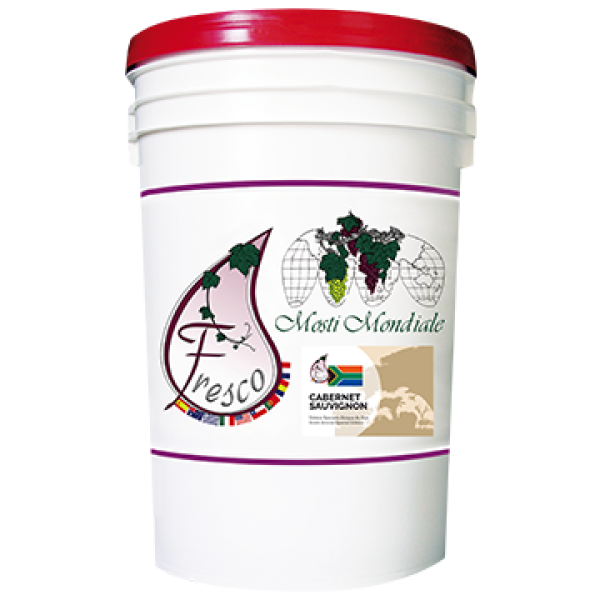
Cabernet Sauvignon
In the world of wines, the Cabernet Sauvignon is one that does not get neglected – and with good reason! The intense mouthfeel coupled with fruity notes of cassis, plums and cherries make this wine an unequivocal master of provoking the senses. Dry, full-bodied and slightly woody arising from the natural overabundance of tannins. If you are courageous enough to set this South African Cabernet Sauvignon aside for 12+ months, it will give new meaning to the phrase “ages like fine wine”!
Body: Full
Aroma: Fruity, Woody
Origin: South Africa
Alcohol: 13.2%
Pinotage
A South African line-up is not complete without a Pinotage. This bold red wine is synonymous with South Africa and it’s no wonder why – its hints of dark and red fruits combine to produce a medley consisting of blackberries, raspberries and licorice on the palate. More subtle flavors include rooibos, tea leaf and flavorful pipe tobacco. The bouquet exudes hints of wood and spices. Relatively high acidity provides a strong finish, making it the perfect pairing for game meats, gourmet burgers and homemade pizza.
Body: Full
Aroma: Fruity, Herbaceous, Spicy, Woody
Origin: South Africa
Alcohol: 13.5%
Sauvignon Blanc
You would be hard-pressed to find a more refreshing wine than a young, crispy South African Sauvignon Blanc. This splendid white wine is made to be enjoyed quite young. The combination of greenish, vegetal and mineral flavors emanating a few weeks after fermentation will make it very difficult to put this one away for a while. Off-dry with a lively acidity and medium finish. Serve slightly cool with light seafood platters.
Body: Medium
Aroma: Herbaceous, Woody
Origin: South Africa
Alcohol: 12.4%
Shiraz
Experience one of South Africa’s most renowned grapes: a dry, full-bodied cherry-red Shiraz with fruity, spicy notes when young. As it ages, subtler flavors like coffee, chocolate begin to take over. The nose slowly develops a hint of charcoal, which adds to the mysteriousness of this classic wine. Enjoy it with company if you really want to share it, but don’t be ashamed of keeping it your own little secret!
Body: Full
Aroma: Caramelized, Fruity, Spicy, Woody
Origin: South Africa
Alcohol: 13.2%
What varieties are available from Australia?

Cabernet Sauvignon
Full bodied deep garnet red. This wine offers up flavors of blackcurrant, blackberries with a slight hint of cedar. The tannin structure of the Cabernet Sauvignon matched with French Oak, create a wonderful symphony of tannins.
Body: Full
Aroma: Fruity, Woody
Alcohol: 13%
Chardonnay
This Australian Chardonnay offers up a complex fruity bouquet, with hints of ripe stone fruit and an underlying citrus note. On the palate it is well balanced with just the right amount of oak enhancing its full bodied flavor.
Body: Full
Aroma: Fruity, Woody
Winemaker addition: Light Oak
Alcohol: 13%
Merlot
Soft and mellow texture right from the start. This Merlot offers hints of cassis with light floral notes.
Body: Medium
Aroma: Floral, Fruity
Winemaker addition: Dark Oak
Alcohol: 12.5%
Orange Muscat
This white wine has citrus and honey notes with a slight sweet finish. On the palate it is fresh and crisp with a lingering clementine flavor.
Body: Light
Aroma: Caramelized, Fruity
Winemaker addition: Sweetener
Alcohol:12%
Petit Verdot
Bold and full bodied, the Australian Petit Verdot offers up flavors of dark fruits; black cherry, plums, with firm tannins and hints of spice.
Body: Full
Aroma: Fruity, Spicy
Winemaker addition: Dark Oak, Light Oak
Alcohol:13.5%
How do I make my own?
Musto Wine Grape Company is here to help you make the wine of your dreams! The Spring winemaking season starts in late April, early May. Secure your winemaking grapes or juices and give us a call at (877) 812-1137 to speak with one of our Musto Crush Crew members. We can get you set up with everything you need and provide customer support along the way to ensure your success!
How to Make Wine from Chilean Winemaking Juice
So how can you start making your own wine from Chilean juices? Follow these 10 Easy Steps (for fresh juice) and you’ll be on your way!
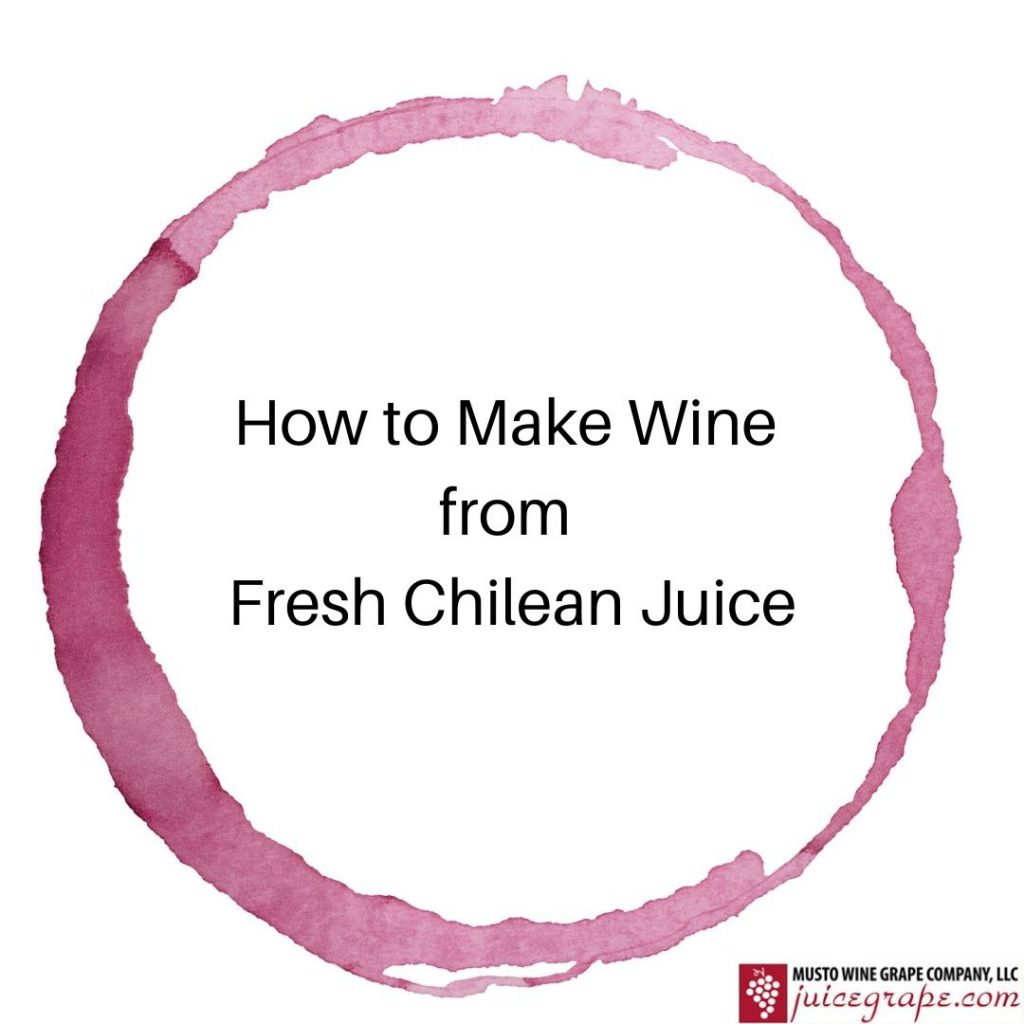
- Choose a Chilean variety that speaks to you.
- Come to Musto Wine Grape and pick up your pail of juice.
- Bring it home, pop open that lid, and add 1/4 tsp potassium metabisulfite to it. Add pectic enzyme if you’re going to (5 drops per gallon of juice). Give it a stir.
- Allow it to come up to room temperature – we’re talking 60 degrees or so.
- Choose your fermentation vessel: will you keep it in pails or ferment in a carboy or demijohn? Make sure everything is clean and sanitized. *Be sure there is enough room to account for fermentation foaming*
- If you are going to add fermentation tannins or additives (like oak dust, Booster Rouge, Booster Blanc) you can add that now. *Note: do not add tannins such as FT Rouge within 8 hours of adding enzyme*
- Pitch the yeast once the temperature has reached at least 60F. Yeast strain choices will vary depending on the juice you choose – ask a winemaker at Musto Wine Grape for a strain recommendation for the varietal you’re making. Follow the yeast starter directions explicitly. Be very careful of temperatures, never adding yeast if there is more than a 18 degree difference between the yeast starter liquid and the juice.
- Carefully monitor the fermentation by checking Brix levels daily. Add yeast nutrients as needed if you choose to do so.
- If you are adding malolactic cultures to your wine, you may also chose to do this at 1/3 Brix depletion. If using a malolactic nutrient (Opti-Malo Plus) with the bacterial culture, hydrate the nutrient in a separate container from the bacteria and add to the must directly before the addition of the bacteria. Follow all directions on the bacteria and nutrient packets explicitly.
- When the fermentation is complete, rack off the lees and continue aging. Many Chilean wines are aged with oak – if you choose to do this, you can do so in oak barrels or with oak alternatives (such as chips or staves).
Want to read more about making wine from Fresh Juice? Check out this blog post.
Can I make my own? Musto Wine Grape Company is here to help you make the wine of your dreams! The Spring Chilean winemaking season starts in late April, early May. Secure your winemaking grapes or juices and give us a call at (877) 812-1137 to speak with one of our Musto Crush Crew members. We can get you set up with everything you need and provide customer support along the way to ensure your success!
A Guide to Cabernet Sauvignon
What is Cabernet Sauvignon?
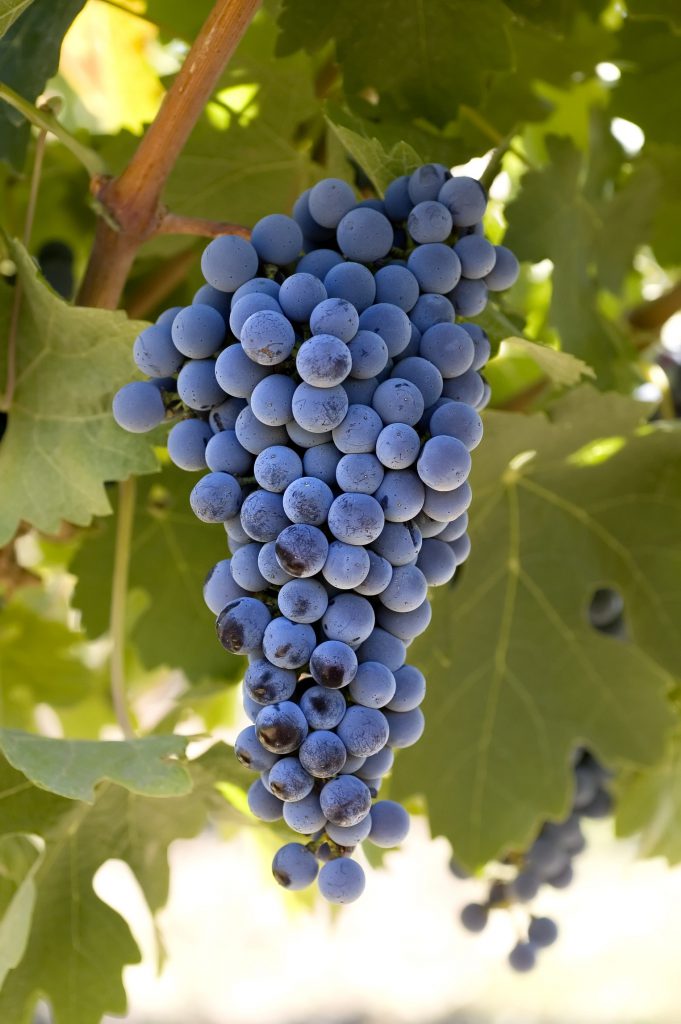
Known as the king of red grapes, Cabernet Sauvignon enjoys the same regal status in California as it does in its native home of Bordeaux, France. Californian Cabernet Sauvignon tends to be more fruit-forward and mellow, with rich dark fruit notes. The most common aromatic and flavor components found in this varietal are plum, black cherry, blueberry as well as warm spice, vanilla, black pepper, and tobacco. Aside from being known for its dark color and full body, it’s known for often being over 13.5% in alcohol content. The average alcohol content of a Cab from California floats around 14.5%. At Musto Wine Grape we carry a variety of Cabernet Sauvignon grapes from multiple AVAs in California, as well as all of the yeasts, nutrients, and equipment you’ll need.
What kind of yeast should I use when making Cabernet Sauvignon?
*Note that full expression of the desired characteristics for any of the following yeast strains is based on proper care and feeding if the yeasts, along with using quality fruit and good winemaking practices. It is also strongly recommended that Go-Ferm and Fermaid-K are used as well as temperature management throughout the entire fermentation. As always, if you need assistance with any part of your winemaking process, do not hesitate to reach out to us at sales@juicegrape.com or give us a call at (877) 812-1137 to speak with someone who can assist with any product recommendations, procedures, or problems.
BM45 yields a big mouthfeel, notes of cherry liquor, rose petal, jam, plum, berry as well as earthy and spicy elements. It offers color stability and helps to minimize vegetative characteristics.
BDX is an all-around great choice for berry, plum, and jam characteristics. It has a moderate fermenting rate and offers good color retention. By re-enforcing existing tannins, it develops structure in the wine. Because of this, we advise to not use with unripe fruit.
RP15 emphasizes the berry aspects of the fruit, along with color stability, increased mouthfeel, and agreeable tannins.
D254 yields a big mouthfeel and rounds tannins as well as intense fruit. It has a focus on berry and jam characteristics, but more so of dried fruit than fresh. It’s also great for color stability and adds body to blends.
D80 offers big volume and fine grain tannins. It is great for encouraging more positive tannin intensity to a blend.
Where do you source your Cabernet Sauvignon from?
We offer Cabernet Sauvignon from multiple AVA’s within California and Washington:
Lanza-Musto Vineyards in Suisun Valley, CA (Valley, 169, 15, and Koch)
Mettler Family Ranch in Lodi, CA
Napa Valley, CA
Washington State (Clone 33)
Sonoma County, CA (Chalk Hill)
Amador, CA
King’s River, CA
Paso Robles, CA
Central Valley, CA
Is there a certain winemaking procedure specific to Cabernet Sauvignon?
You can follow our Red Wine Grape Procedure which you can find here, if you are using juice you can find the procedure here and if you are using frozen must, here. The procedure is standard for making red wines, but using the proper yeasts and nutrients specific for Cabernet Sauvignon and consistent monitoring will have the biggest impact on your final wine.
Where can I buy grapes, juice, or must?
At Musto Wine Grape Company, all red grape varieties are available in 36lb cases, in frozen must by request, or in 6-gallon fresh juice pails. For Sterile Juice options that can be shipped year-round and without refrigeration click here.
Finally, if you need the best options and equipment suited for you and your winemaking goals, email sales@juicegrape.com or call (877) 812 – 1137 to speak with one of our Musto Crush Crew members who can help. We are here to provide all of the winemaking products you need to make the wine of your dreams, as well as the customer support to ensure your success!
2020 Winemaking Juice Update {071720}
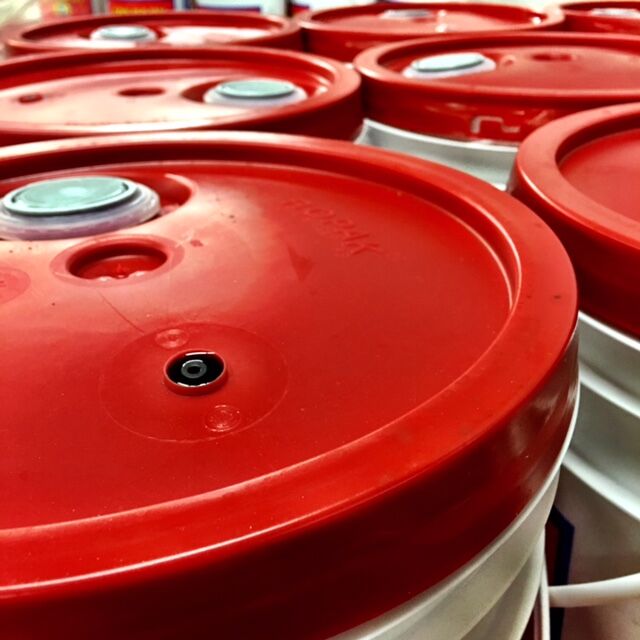
We anticipate that we will have Winemaking Juices the week after Labor Day! It’s time to plan this year’s vintage and we have a lot of juice options for winemaking this season!
California:
We have many labels of high quality winemaking juices coming in from California this fall. Cry Baby, Bella California, Lodi Gold, California Select, and Colina del Sol, just to name a few. The fresh juices are stored at 35 degrees and arrive as if the juice just came out of your wine press. You can either hit the juice with SO2 and inoculate with your chosen yeast, or you can let the juice warm up and ferment using the native yeast found in the skin of the crushed/pressed grape.
Lanza Vineyard Juices:
The Lanza winemaking juices arrive directly from Lanza-Musto Vineyards in Suisun Valley, CA. Varieties available are – Muscat Cannelli, Rose of Gamay (Pink), Chardonnay, and Sauvignon Blanc. They come in 5.25 gallon pails, are cold settled, with zero adjustments made to the juice. If you want Suisun Valley fruit but don’t have a crusher these are a great option.
Fresco Juices:
Mosti Mondiale Fresco is proud to be the only product to offer home winemakers their own vineyard in one unique package. Each pail is carefully pre-balanced, inoculated with the perfect yeast, and infused with liquid enzymes to help create a delicious and palate pleasing wine. The Fresco juices come from California, Australia, and Italy.
Italian Juices:
Our Italian juices will arrive in late October. The Italian juices are always full of flavor and provide palate pleasing, age worthy wines.
Give us a call or shoot us an email to discuss your 2020 vintage!
877-812-1137 – sales@juicegrape.com
Harvest Update – 8/29/19
Hey Winemakers!
Our growers are officially harvesting in California! Click the link below to hear more about our upcoming wine grape and wine juice arrivals. As well as information about our new offerings of wine grapes and wine juices.
http://bit.ly/HarvestUpdate082919
Video Notes:
Harvest has begun in Central Valley around August 28th with grapes and juices arriving after Labor Day – As early as Wednesday September 4th.
The first grapes will most likely be Albarino, Alicante, Barbera, Carignane, Chardonnay, Mixed Black, Muscat, Petite Syrah, Pinot Noir, Pinot Grigio, Syrah, Thompson Seedless, and Zinfandel. From Central Valley and King’s River Ranch
New items added to our offerings list this year.
RR Pinot Noir – from the Slusser’s family ranch. They have owned their ranch in Sonoma, specifically the Russian River Valley since 1848. They traded cattle with the Indians for the original property. Caroline, the vineyard manager is 6th generation farming her family’s wine grapes. Should be some epic Pinot Noir coming from that vineyard!
New and interesting grapes added to the menu are Touriga National, Teraldego, and Black Muscats. Some of the Musto Crush Crew created some wines from these grapes this year. Feel free to reach out to us for more information and winemaking recipes.
Washington State: Wahluke Slope has one of the driest, warmest climates in the state, allowing nearly complete control of vine vigor and ripening through irrigation. Washington State is worth the wait!
Lanza Musto Petite Sirah and Brunello Clone Sangiovese are looking great! SB should be harvested in the next two weeks.
Keep an eye on our Harvest Tracker and Juicegrape.com Blog for real time grape and juice arrivals, as well as harvest updates and helpful winemaking tips information.
Please reach out to us with any questions via email or phone.
877-812-1137 – sales@juicegrape.com
Happy Wine Season!
Making Italian Amarone from Juice: How to Drink like a Millionaire, but Make Wine on a Budget
A Little About Amarone:
The Italian Amarone wine is famous for its strong, tannic character and full bodied flavors of dried fruit. Rich and complex, it is a benchmark Italian wine, often challenging to recreate until now. Amarone develops its rich and complex character from partially drying the grapes, then fermenting them, decreasing the fruit to skin ratio. The higher levels of skin contact will give the intense tannins and dried fruit character that the style is known for.
How to Make Amarone/Amorosso from Fresh Juice:
When making Amarone with fresh juice, there are certain ingredients that you may add as the winemaker to help replicate the classic style and methods. To increase the skin contact for the juice, you can purchase an All-Grape add pack to add into your bucket of juice. The All-Grape pack is simply just that, wine grape skins and juice, designed to add more tannins and complex flavors to juice. The tannins found in the grape skins will become soluble in the juice and add more of the traditional Amarone character to it.
Juice Options:
Winemaking Kit Options:
A way to increase the tannin content at fermentation and mimic the classic style is by adding supplemental tannins. Yeast naturally consume some tannins throughout their metabolic process of fermentation. Without adding additional tannins, they will consume some of the grape tannins that give Amarone its unique style. By adding some very cost effective fermentation tannins such as oak dust or FT Rouge, additional tannins will be available to the yeast for their process, therefore preserving the grape tannins for the consumer. FT Rouge is a natural oak derived tannin that will not only provide stronger tannic character, but will also help to enhance and secure color. Apply FT Rouge at 1gram/gallon. Oak dust will also supply some “sacrificial tannins” to the yeast fermentation process. The yeast will consume these tannins, leaving the more favorable, smother grape tannins for the consumer.
Winemaking Add Ons:
- FT Rouge
- All Grape Pack
- Oak Dust
Another way to enhance your process of making Amarone from juice will be in your yeast and bacterial selection. Some yeasts that will enhance the rich fruit character of the Amarone juice are BM 4×4 and RP15. Both yeasts have a higher temperature tolerance and will help to secure the rich color. To recreate a traditional Amarone closely, the perception of acidity will need to be reduced. Using malo-lactic bacteria to metabolize the harsher malic acid, and turn it into lactic acid, which has a smoother, creamier mouthfeel, is a vital step in creating a traditionally styled Amarone. This bacterial fermentation can take place at the same time as the primary yeast fermentation, so that the bacteria will benefit from the available nutrients and heat generated via the yeast fermentation. For an individual bucket, we sell a pouch of bacteria that are very easy to use. Simply wipe the pack with sanitizer and stir it into the wine. The bacteria will finish up their fermentation shortly after the yeast finish their fermentation; approximately 2-3 weeks after it is inoculated.
Yeast Suggestions:
To round out the full bodied flavor and profile of Amarone, the winemaker will have to add oak to create a balanced bouquet. After fermentation, the winemaker should consider the addition of oak via a traditional barrel or a supplement, such as oak chips or staves. These will add additional tannic character, creating the Amarone most closely to its traditional style.
Aging Additions:
by the Winemakers at Musto Wine Grape
If you are interested in sourcing Italian Juices for winemaking please contact us at sales@juicegrape.com or 877-812-1137.
JUICES IN STOCK AS OF 9-1-17 AND GRAPE ARRIVALS
Juices In Stock as of 9/1/17 and Grape Arrivals
JUICES:
Labels Available California Select:
|
Variety |
|
Barbera |
On the Road…. Safe to say all of this should be in by the Friday September 8th!
GRAPES:
|
Variety |
Label |
|
Merlot |
Smiling Baby |
|
Zinfandel |
Valley Beauty |
|
Seedless |
Smiling Baby |
|
Grenache |
Smiling Baby |
|
Zinfandel |
Valley Beauty |
|
Albarino |
Cry Baby |
|
Alicante |
O’Caprio |
|
Petite Sirah |
Cry Baby |
|
Syrah |
Cry Baby |
|
Ruby Cab |
Uva di California |
|
Old Vine Barbera |
Lucerene |
|
Old Vine Barbera |
Lugano |
|
Pinotage |
Costmagna |
|
Merlot |
Smiling Baby |
|
Pinot Noir |
|
|
Albarino |
Lodi Gold |
|
Chardonnay |
Lodi Gold |
|
Pinot Grigio |
Lodi Gold |
|
Viognier |
Lodi Gold |
|
Zinfandel |
Valley Beauty |
|
Grenache |
Smiling Baby |
|
Zinfandel |
Lucerene |
|
Chardonnay |
Lodi Gold |
|
Seedless |
Lucerene |
|
Seedless |
Loidi Gold |
|
Black Muscat |
Cry Baby |
|
Symphony |
Cry Baby |
|
Seedless |
Cry Baby |
|
Tempranillo |
Cry Baby |
|
Alicante |
O’Caprio |
|
Seedless |
Miss Seedless |
|
Old Vine Barbera |
Lugano |
JUICES:
Labels Available: California Select, Cry Baby, Colina
|
Variety |
|
Barbera |
The Winemaker’s Think Tank: Vol 14 – What temperature should my juice be before yeast is added?
What’s the Winemaker’s Think Tank?
Every Thursday we will post about a few frequently asked questions that our winemaker has answered. If you have a winemaking question you would like to have answered, please email us at support@juicegrape.com and we will try to get into next week’s post. Cheers! 🙂
What temperature should my juice be before yeast is added?
The ideal temperature for most yeast strains to conduct a successful fermentation is between 60-70 degrees Fahrenheit. Be sure that the juice is at least 60 degrees before adding any yeast to ensure that the yeast will not die of cold shock when added to the wine.
Check out Musto’s Youtube Video below for Step by Step Yeast Starter Instructions from Winemaker & Bootcamp Professor Frank Renaldi.
We hope this information helps with your winemaking. If you have any follow up questions or winemaking questions in general, please email us at support@juicegrape.com.
The Winemaker’s Think Tank: Vol 2 – What do I need to get started making wine with fresh juice?
The Winemaker’s Think Tank?
Every Thursday we will post about a few frequently asked questions that our winemaker has answered. If you have a winemaking question you would like to have answered, please email us at support@juicegrape.com and we will try to get into next week’s post. Cheers! 🙂
What do I need to get started making wine with fresh juice?
When elevating your winemaking to the next level, often sourcing the best ingredients is the most direct path to better results. After getting great base experience using wine kits, the next logical step to wine making greatness is fresh juice. When making this change from wine kits to fresh juice, other ingredients may be needed to ensure the juice will reach its greatest potential as wine. First, evaluate your juice for acid (pH) and sugar (Brix). What are the levels present in your juice? If the Brix level is below 20, you may consider adding sugar to increase the Brix levels to 24-26. What is the pH of the wine? Juice should have a pH greater than 3.1 to ensure a successful fermentation. If the pH is higher than 3.8, consider adding tartaric acid. This will ensure a better tasting wine after fermentation as well as a more stable wine.
The next area to consider is yeast. Certain strains of yeast will amplify certain traits within the finished product of wine such as fruit character, spice notes, or floral notes. The yeast has certain parameters that it will ferment best within, so consult a winemaking expert at Musto Wine Grape to help you select the best yeast strain for your wine. The yeast is the important catalyst that will process the grape juice into wine. The yeast will need certain nutrients to best assist it with its fermentation such as a rehydration nutrient like Go Ferm, and subsequent nutrients to finish out the fermentation process such as Fermaid O and Fermaid K. Musto Wine Grape stocks yeast along with all of the aforementioned nutrients in small packages, designed for the individual buckets of juice. This will give you perfectly measured amounts of products to add to your wine, making proper fermentation simple and with no wasted/unused product.
We hope this information helps with your winemaking. If you have any follow up questions or winemaking questions in general, please email us at support@juicegrape.com.






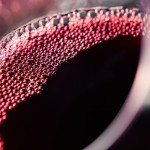

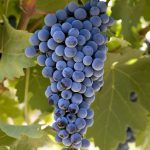

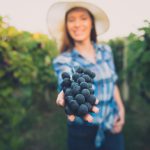
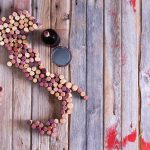

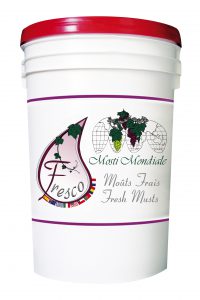
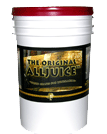
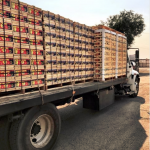
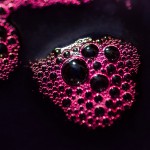
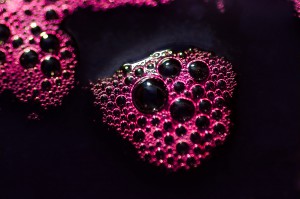
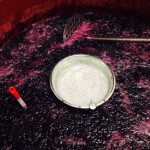


Recent Comments